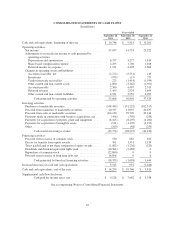Apple 2013 Annual Report Download - page 54
Download and view the complete annual report
Please find page 54 of the 2013 Apple annual report below. You can navigate through the pages in the report by either clicking on the pages listed below, or by using the keyword search tool below to find specific information within the annual report.The Company has identified up to three deliverables regularly included in arrangements involving the sale of
these devices. The first deliverable is the hardware and software essential to the functionality of the hardware
device delivered at the time of sale. The second deliverable is the embedded right included with the purchase of
iOS devices, Mac and Apple TV to receive on a when-and-if-available basis, future unspecified software
upgrades and features relating to the product’s essential software. The third deliverable is the non-software
services to be provided to qualifying versions of iOS devices and Mac. The Company allocates revenue between
these deliverables using the relative selling price method. Because the Company has neither VSOE nor TPE for
these deliverables, the allocation of revenue is based on the Company’s ESPs. Revenue allocated to the delivered
hardware and the related essential software is recognized at the time of sale provided the other conditions for
revenue recognition have been met. Revenue allocated to the embedded unspecified software upgrade rights and
the non-software services is deferred and recognized on a straight-line basis over the estimated period the
software upgrades and non-software services are expected to be provided for each of these devices, which ranges
from two to four years. Cost of sales related to delivered hardware and related essential software, including
estimated warranty costs, are recognized at the time of sale. Costs incurred to provide non-software services are
recognized as cost of sales as incurred, and engineering and sales and marketing costs are recognized as
operating expenses as incurred.
The Company’s process for determining its ESP for deliverables without VSOE or TPE considers multiple
factors that may vary depending upon the unique facts and circumstances related to each deliverable. The
Company believes its customers would be reluctant to buy unspecified software upgrade rights for the essential
software included with its qualifying hardware products. This view is primarily based on the fact that unspecified
software upgrade rights do not obligate the Company to provide upgrades at a particular time or at all, and do not
specify to customers which upgrades or features will be delivered. The Company also believes its customers
would be unwilling to pay a significant amount for access to the non-software services because other companies
offer similar services at little or no cost to users. Therefore, the Company has concluded that if it were to sell
upgrade rights or access to the non-software services on a standalone basis, including those rights and services
attached to iOS devices, Mac and Apple TV, the selling prices would be relatively low. Key factors considered
by the Company in developing the ESPs for software upgrade rights include prices charged by the Company for
similar offerings, market trends in the pricing of Apple-branded and third-party Mac and iOS compatible
software, the nature of the upgrade rights (e.g., unspecified versus specified), and the relative ESP of the upgrade
rights as compared to the total selling price of the product. The Company may also consider additional factors as
appropriate, including the impact of other products and services provided to customers, the pricing of
competitive alternatives if they exist, product-specific business objectives, and the length of time a particular
version of a device has been available. When relevant, the same factors are considered by the Company in
developing ESPs for offerings such as the non-software services with additional consideration given to the
estimated cost to provide such services.
In 2013, 2012 and 2011, the Company’s combined ESPs for the unspecified software upgrade rights and the
rights to receive the non-software services included with its qualifying hardware devices have ranged from $5 to
$25. Beginning in September 2013, the combined ESPs for iPhone and iPad were increased by up to $5 to reflect
additions to unspecified software upgrade rights due to expansion of essential software bundled with these
devices. Accordingly, the range of combined ESPs for iPhone and iPad as of September 2013 is $15 to $25.
Beginning in October 2013, the Company anticipates increasing the combined ESPs for Mac from $20 to $40 to
reflect additions to unspecified software upgrade rights related to expansion of bundled essential software.
Revenue allocated to such rights is deferred and recognized on a straight-line basis over the estimated period the
rights are expected to be provided for each device, which ranges from two to four years.
Shipping Costs
For all periods presented, amounts billed to customers related to shipping and handling are classified as revenue,
and the Company’s shipping and handling costs are included in cost of sales.
52
























